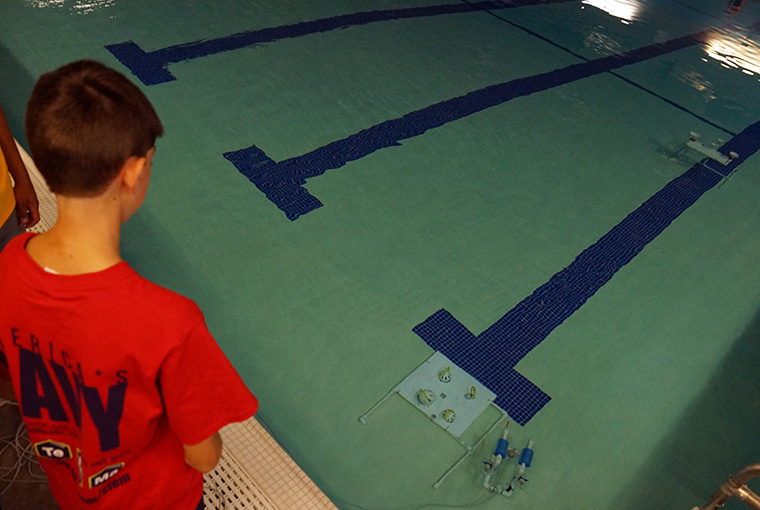Inspiring the Next Generation of Scientists: U.S. Naval War College Holds 7th Annual Starship Poseidon STEM Camp

NEWPORT, R.I. -- Twelve teenagers stared intently into the pool. There was little chatter. Even cell phones were put away, mostly.
All eyes were on a bundle of plastic tubes darting around beneath the water.
The teen with the controller attempted to use his remotely operated underwater vehicle to drop a plastic ball into a cup. More often than not, the ball slid away, missing the target.
The students groaned. Science is hard – harder than video games.
“It was cool to build it and see that it worked OK,” said 14-year-old Liam Carroll, from Lincoln, who seemed to understand the value of experimentation despite his team’s less-than-stellar performance in the underwater target competition.
“There are things you can change next time.”
Nearly 80 high school students from southern New England are at Naval Station Newport this week for the Starship Poseidon STEM Camp, an annual summer event focused on science, technology, engineering and math, or STEM.
The camp is put on by U.S. Naval War College faculty and sponsored by the Office of Naval Research.
The students spend the week discovering that science and math can be fun – and challenging – when used in real life, as the U.S. Navy does every day. The event culminates in a graduation ceremony Saturday.
“You get to see cool stuff, like the technology on a submarine,” said Leah DiCenso, 16, of North Kingstown, who is attending the camp for the third year.
The students are given science challenges and asked to build projects that respond to the scenarios.
For example, can you build a remotely operated vehicle that performs tasks underwater? Or, can you assemble an all-terrain toy truck powered by solar panels? Or, can an egg be dropped from a six-foot height without breaking, if cushioned properly by paper and drinking straws?
Teacher Christina Fontana assigns the solar-panel truck challenge.
“They are learning analytical skills and critical-thinking skills and collaborating with peers,” said Fontana, a high school chemistry teacher during the school year in Fall River, Massachusetts.
“I start off by saying, ‘Sketch it. What’s your vision?’ If they are nervous, I say, ‘Go for it.’ I like for students to understand that science isn’t a one-time thing. You have to go back and revise.”
The Starship Poseidon camp started in 2012. It sprang from a conversation between Naval War College Associate Provost Will Bundy and an official at the Office of Naval Research, which was looking for another opportunity to spread awareness of Navy science and technology careers.
The first camp in Newport had 25 students. Since then, attendance has grown and so have the topics covered during the week-long event. This year, 78 Starship students are being introduced to robotics, medical technology, chemistry, solar power, hydraulics and, for the first time, design in physics.
“The idea is to expose the students to, not only the math and science around STEM, but the practical applications. We show them applications in the Navy,” Bundy said.
“We have them take a tour of the USS Constitution so they can see that, in the old sailing days, there were technology advances then with pulleys and how the ship was constructed.”
For a look at modern science, the teens visit the Naval Undersea Warfare Center in Newport, where civilian and military scientists work on technology that goes on today’s Navy ships.
Students also go to Groton, Connecticut, to tour the historic submarine Nautilus and the Submarine Force Museum. At Naval Submarine Base New London, the students get to see the Naval Submarine School and tour a working fast-attack submarine.
This year’s visit to the submarine USS Providence (SSN 719) was a crowd pleaser.
“I came in thinking, ‘Oh, boy, a ton of people trapped in a steel can! That must stink,’” said Harry Dunn, 16, of Barrington. “But it was super interesting. And they have a real sense of purpose and camaraderie when you were walking through. You typically wouldn’t get to see that kind of stuff.”
Back in Newport, students stay in dorm rooms at Naval Station Newport and eat their meals in the base mess hall – just like the sailors attending one of the base’s various training schools. This elbow-rubbing offers a gentle look at Navy culture for students, who might be interested in future careers – either in uniform or as a civilian scientist, Bundy said.
Of the more than 300 graduates of the Starship camp since 2012, several have gone on to earn positions at the U.S. Naval Academy and U.S. Coast Guard Academy or scholarships in the Navy's ROTC program. Many more have gone on to study science in college.
“This is a not a military experience for them – we do not teach close order drill,” Bundy said. “We make it that way because we want them to think about becoming the engineers and scientists we need in our workforce in order to compete in this global competition.”
There’s no prerequisite that students already show good scores in STEM classes. It’s enough that they show a glimmer of excitement about the topics, officials said.
“The goal of the program is to get students interested in science, technology, engineering and math with the hope that they will come back and support the Navy,” Bundy said.
For more information on this annual summer camp, go to starshipstem.org.
